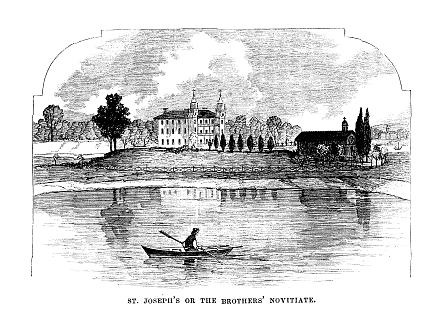The Island

Year 1844 . . . Chapel of the Novitiate

Year 1844 . . . Chapel of the Novitiate
In the month of November 1843, as F. Sorin was making his retreat on a little island beyond the Lake, he found the place admirably suited for a Novitiate for the Brothers, and as there remained only one year more, according to the contract of donation, to build the house, he did not think he was losing his time by spending his leisure hours in drawing up the plan of the Novitiate as it was afterwards carried out.
The corner stone of the chapel contained in his plan was blessed in May of the following year, 1844. The building of this chapel was in fulfilment of a vow made by F. Sorin on occasion of the sickness of one of the Sisters. The work on the university did not permit the continuance of that on the chapel before the month of November; but then such was the activity of the workmen in this matter that in seven and a half days the walls were up, and eight days more sufficed to build those of the Novitiate.
The chapel and the novitiate were blessed on Dec 8th of this same year under the title of the Most Holy and Immaculate Heart of Mary, and on the same day the Archconfraternity was there solemnly established. On the same day also two Sisters made their profession: Mary of the Five Wounds, and Mary of Bethlehem, and one postulant, Mary Coffee, received the habit with F. Moreau's name, Sr. Mary of St. Basil.
From this time until the end of 1848, when the new church was dedicated, this little sanctuary became the favorite spot of the whole house. There the community assembled in times of distress or of rejoicing; there were published the general prescriptions or regulations in regard to the common welfare; there each year the retreat of the Brothers was made, and even that of the priests. There also later on (after March 19th, 1847) they came to venerate the precious relics, the holy body of St. Severa, presented to this chapel by Mgr. Dela Hailandiere on his return from Rome in 1845; thither also they came to honor the Passion by making the Way of the Cross, which was there canonically erected on March 14th 1845.
[1860] In front of St. Aloysius's novitiate and close to it is that of the Brothers, recently built on the site of its predecessor, and larger than it by one half. It has at present some fifty novices and postulants. It is the only house at Notre Dame where the Brothers are represented by themselves, and in a manner somewhat worthy. The St. Joseph's novitiate is built on a charming little island which forms a considerable elevation between the two lakes. It is the most beautiful spot of the whole property, and in a short time, when the plan shall have been fully carried out, it will be really charming.
In November, 1843, Father Sorin drew apart from the community to make his retreat in silence and seclusion. The spot he chose was called simply "The Island." It was an eminence between the two lakes, the site now occupied by the Community House. It was surrounded by marshy ground. One had to use a boat to get to it. During his retreat Father Sorin experienced such peace and freedom from care that he determined there should be the spot where novices, in prayer and study, should lay the foundation of the spiritual life. There, he felt, they would receive that godly strength of which they would stand in so great need if Notre Dame were to succeed. Even during the days of his retreat Father Sorin chopped down trees and cleared some of the ground, while he thought over the kind of building he would erect. It was not until the following summer, 1844, that he was able to proceed. But by December 8, 1844, two buildings had gone up, the novitiate and a chapel. Father Sorin surveyed his work. The Bishop had said, "Within two years, let this be done." Well, it was done.
This chapel on the island was to be the spiritual center of the Congregation of Holy Cross in Indiana. There is no trace of it today. It was torn down in 1858 to make room for a larger building. But in the early days it was the place, above all others, where the Community really enjoyed itself. All the old records speak of it with reverent attachment. In the morning, at meditation, Mass and Communion; in the evening, when the community, in two canoes, paddled to its shores, recited the beads and said the Litany; on the days of retreat; the anniversaries of profession and ordination -- always this place, above all others, was sanctified by a religious peace. For years it was the only thing at Notre Dame that made any pretention of being extra fine.